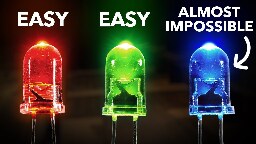Why It Was Almost Impossible to Make the Blue LED


youtu.be
The blue LED was supposed to be impossible—until a young engineer proposed a moonshot idea.
You are viewing a single comment


The blue LED was supposed to be impossible—until a young engineer proposed a moonshot idea.
This was an yet another glorious episode from veritasium.
I hope we get well past UVC LEDs. (i.e., shorter wavelengths) UV LEDs are already available. Unfortunately, this progress will stop before X-ray light. With +1 KeV energy, you pretty much must blast off the electrons from the atoms to emit X-rays, which an x-ray tube already does. Or by peeling off a piece of scotch tape.
Maybe making X-ray emitters cheap enough to put in a flashlight isn't the best idea anyway.
Maybe not in a flashlight, but the scientific industry would be very pleased with them. Sterilize water and all surfaces in a second? Flash with 200nm light.
Handheld battery powered X-ray devices exist and are widely available. I used to work with those. In Germany you need a permit to operate them. https://www.thermofisher.com/order/catalog/product/de/en/XL2
What’s wrong with the current UV tubes? Sure, the smaller ones take about 5-10 W to get the job done, so maybe an LED version would be more efficient. If you’re using UV to keep a massive pool clean, then you’re obviously going to be need more of those bulbs, and they can add up to hundreds of watts quite easily. Is that really a big problem though? Having a pool isn’t cheap, so electricity spent on UV probably isn’t going to be your main concern. Making it cheaper is always welcome, but are UV tubes really that big of a problem?
I mean they aren't instant and have to be within a fairly short distance of the thing you want to sterilize in order to work because they are absorbed by the air. Something like a pool would be practically impossible as water also absorbs UV and a pool is too big to penetrate all the way through just from the sides or bottom. It only works for drinking water because you pass said water through a tube that must be fairly narrow.
Oh yeah and an X-ray could sterilize all the way through an object, not just the surface. Very useful for making things like microwave meals.
How about cheap enough to put in a fleshlight?
If you have a bone in your penis, you may not be fully human.
Otherwise, don't x-ray your penis.
Good advice, but I put a Kleenex in my urethra for safekeeping and I'd love to track it down to get it out again.
Amateur. It's in the scrotum along with all the pee.
Next time you have to fart just squeeze your butt cheeks together real hard. It’ll pop right out.
The fart?
You tell me. Your user name suggests some expertise.
/c/flashlight sends its regards
D4V2 x-ray edition when?
More efficient compact X-ray generators would be pretty huge for science work. We run the diffractometer in my lab at 2 kW and it still takes hours to get a good quality scan
Sorry sir I have no idea what you are talking about
Light = energy, shorter wavelengths= higher energy. Blue light has a shorter wavelength than red light. UV has even more energy. X-Rays have a lot more energy. For reference in the visible spectrum were talking about maybe 1-4 eV (this may be wrong, I'm too drunk to look it up rn).
If we want to produce light, the aim is to find an energy gap that has the exact energy gap that corresponds to the wavelength we're interested in. Typically this corresponds to an electronic transition, i.e. an electron "jumps" into a higher orbital, on its way down it will emit the energy difference as light.
2.1 X-Rays rn are produced by accelerating electrons onto a metal plate with high voltage. The impact of the electron "rips" out an electron in the close vicinity of the nucleus. Another electron will take the place of that electron, the energy gap associated with that process is large, which is why it produces X-Rays.
If we want to produce LEDs that emit in the far UV range we have to find large energy gaps in materials which is difficult. We still have to have a way to get the electron across the energy gap using electricity.
X-Ray LEDs are probably not realistic, as the energy of x-rays is so large that we have to rip out electrons from the close vicinity of the nucleus... which is already what we're doing with X-ray tubes.
Get past uvc for what purpose?
I imagine that lithography for integrated circuits would be an application, assuming you could make an appropriate photo-resist. The shorter the wavelength, the smaller the possible feature size. Current lithography relies on constructive and destructive interference between wavelengths to create super small features.
As far as "light" it's already capped out, then. Going shorter there's only x-ray and then Gamma ray. Gamma ray lithography sounds bad-ass and dangerous.
Gamma rays have so much energy that they are basically emitted only by nuclear processes, as far as I know.
Until we stick it in an led!
I guess past the uv range we should just call them ED, but then you only think about erectile dysfunction.